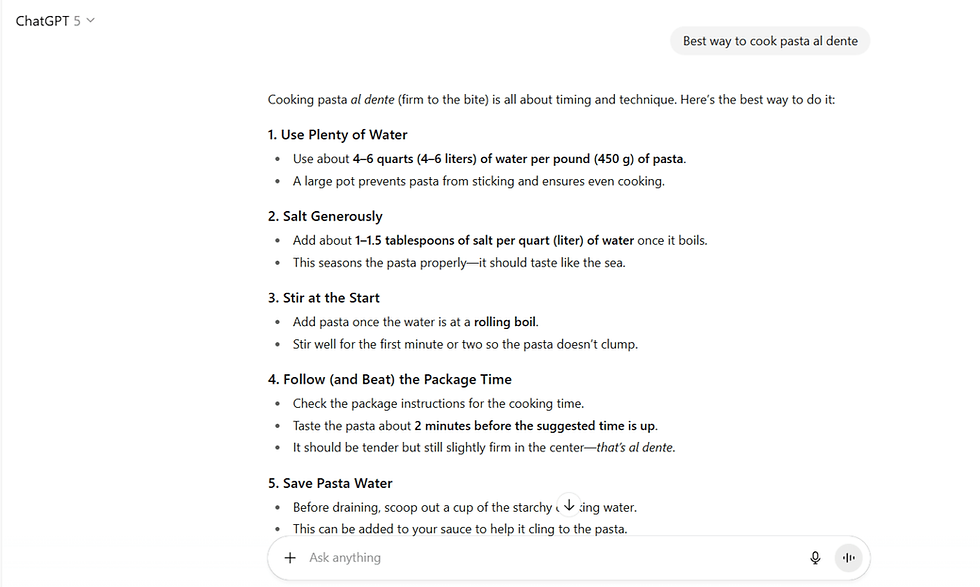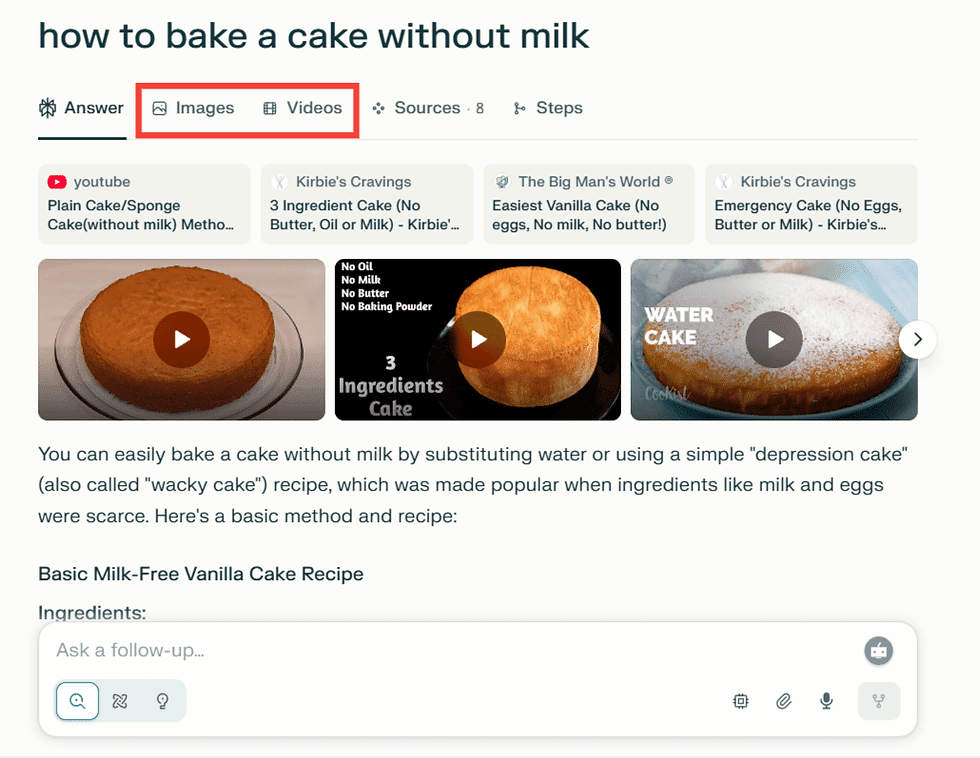- Maddy Osman
- 4 days ago
- 6 min read
Updated: 17 hours ago
Perplexity, a large language model, is quickly becoming a major player in AI search.
It currently accounts for only 2% of AI search queries, but this represented 780 million monthly searches as of May 2025; a huge increase from 230 million just nine months prior.
On Perplexity, visibility comes from being cited as a trusted source in its AI-generated answers. That visibility builds credibility, even if the traffic volume is much smaller than that of Google.
With that in mind, let’s break down how to rank in Perplexity to boost your brand’s visibility as part of your generative engine optimization efforts.
What is Perplexity and why are people turning to it?
Perplexity is an AI-driven search engine powered by large language models (LLMs). It answers users’ queries with consolidated responses, complete with source citations, rather than providing a list of links on a page like traditional search engines do.
To better illustrate this point, let’s compare how Google, ChatGPT, Claude, and Perplexity respond to the same query: best way to cook pasta al dente.

Google generally displays search results with a list of blue links to ads, blog posts, reviews, and forums that you must click through to get your answer. In many instances, you may get an AI Overview that gives you an overall summary.
ChatGPT's extensive training data means that even when web-enabled, many models will reference their store of knowledge instead of websites for questions on general topics. This means citations and links are not guaranteed for every chat conversation.

Claude AI responds with a well-structured AI-generated answer, much like ChatGPT, and doesn’t cite live web sources by default.

In contrast, Perplexity AI gives you a clear answer right on the results page by pulling together insights from several trusted sources. It also shows where the information comes from, with clickable source cards listed at the top of the response. This helps you get quick, authoritative responses without needing to dig through a bunch of different links.

Because Perplexity provides summarized responses with multiple cited sources, the goal isn’t to rank on the first page of a list of search results. Instead, it’s about being included as one of the cited sources in the answer.
So, how do you "rank" in Perplexity?
How Perplexity ranks content
Perplexity uses advanced language models like Claude 4.0 Sonnet and GPT-5 to understand the meaning behind your question.
Once it understands the context of what you're asking, it searches the web in real time and pulls information from authoritative sources like reputable blogs, websites, and academic or industry-relevant journals. After gathering the most relevant insights, it summarizes them into a clear, conversational answer with clickable links to the sources.
If you’re a paid user, you can also choose your preferred model from the dropdown.

The model choice affects how your query is interpreted and how the answer is written. Some models summarize more concisely, while others provide richer detail or different reasoning styles. Regardless of which model you select, Perplexity will still ground its responses with real-time citations.
Beyond how answers are delivered, there’s also a shift in how people search on Google and on AI chatbots. In a Google search, someone might type something short and keyword-focused like “best tools to track AI search visibility.”
But in Perplexity and other generative AI chatbots, the same person might ask something like, “I’m just getting started in GEO, and I need an affordable tool to help me understand my brand's visibility in LLMs.”
That shift, from keywords to conversational prompts, changes what kind of content gets surfaced. For your content to be cited in Perplexity and other AI chatbots, it needs to do two things:
answer real user questions in natural language
be from an authoritative source
How to optimize your content to rank in Perplexity
First, a few best practices for generative engine optimization in general:
Double down on authority and trust
Sixty percent of Perplexity’s citations overlap with the top 10 Google results for the same query, according to BrightEdge research on Perplexity. This suggests that solid keyword optimization and trust signals (like backlinks and demonstrated expertise) increase your chances of being cited.
Authoritative “best of” lists help, too. A 2024 survey by FirstPageSage found that these mentions account for 64% of Perplexity’s general recommendation algorithm, much more than online reviews (31%) or awards and affiliations (5%). Even in its local recommendation algorithm, authoritative list mentions contribute a significant 34%.
This means you’ll want to pitch review sites and high-authority blogs that compile “best of” or “top product” roundups. Perplexity and other AI tools tend to favor authoritative list-style articles because they organize and rank top products or companies in a specific category, making it easier for the AI to identify credible options and generate helpful recommendations.
On a similar note, you should also highlight any awards your brand has received. When Perplexity crawls your site, finding these accolades can boost its confidence in your expertise.
Use clear structure and formatting
Break up your content with descriptive headings, bullet points, and summaries to make it easy for both humans and AI to scan. It also helps to include Q&A-style sections or headings that match the way people phrase their questions.
You can take it a step further by adding structured data (like FAQ schema markup) to give the AI models clearer signals about what your page covers. A 2023 study by Data World shows that when LLMs are powered by structured data or knowledge graphs, their responses improve by 300%.
Now, some ways to target Perplexity in particular:
Include multimodal sources in your content
Perplexity often surfaces results across different tabs, including Images and Videos, which means well-optimized video content and visuals can directly influence visibility.

If you offer tutorials on how to use your product or service, it’s best to create YouTube videos for it, as Perplexity often cites explainer videos from YouTube for related queries. Similarly, images and infographics with clear file names, descriptive alt text, and labeled data can appear in Perplexity’s image results, giving your brand more presence across answer types.
Engage on Reddit (even more)
Reddit plays a big role in Perplexity’s citation patterns. Data from Profound shows that between August 2024 and June 2025, Reddit accounted for 46.7% of Perplexity’s top 10 citations. In contrast, among ChatGPT’s top 10 most-cited sources, Reddit makes up just 11.3%, with Wikipedia winning at 47.9%.
When engaging on Reddit, focus on being genuinely helpful and contributing expertise to conversations. Communities like Reddit are quick to downvote or block overt marketing, but they reward brands (and individuals behind them) that answer questions, share useful resources, or add perspective without pushing a sales agenda.
Adopt LLMs.txt
As of August 2025, major AI players, including Perplexity, have incorporated LLMs.txt into their own website architecture. LLMs.txt is a proposed standard and structured text file that allows LLMs to easily understand a website.
Adoption is still early, but it’s a forward-looking strategy for site owners who want to stay competitive in this space. Note: If you have a Wix Premium eCommerce site in the United States in English, the system will automatically generate this file for you.
And get involved in Perplexity’s programs:
Join Perplexity’s Merchant Program
If you sell products, take advantage of Perplexity’s Merchant Program. This program lets eCommerce brands share their product details directly with the AI search engine to increase the likelihood of being featured in product recommendation responses, much like how Google Shopping provides listings based on relevance and availability.
The Merchant Program is completely free to join; you just fill out a short online form with a few details about your brand. Once approved, your product data (like specs, pricing, images, and availability) gets indexed by Perplexity, which helps it better understand what you offer so that your products are recommended in relevant shopping queries.
Join Perplexity’s Publisher Program
The Publisher Program is designed for media companies and online publishers who want their content cited inside Perplexity’s answers while also benefiting from new revenue opportunities.
The program offers benefits like:
Revenue sharing from ads shown on related questions where your content is cited
Access to Perplexity APIs to build custom answer engines on your own site
Free Perplexity Enterprise Pro for all employees for one year
Analytics and insights to track how your content is being cited and how it’s performing
To join the program, email publishers@perplexity.ai, and the Perplexity team will reach out to you.

Use Perplexity Pages
With Perplexity Pages, you can create engaging articles that live inside Perplexity’s ecosystem, where they can be surfaced in user searches. You can customize the tone, adapt the structure, and add visuals to make your content resonate with your audience.

To get started, simply log in to your Perplexity account, go to the Library tab, and select “Create a Page.” (Or, go to Perplexity Pages here.) Then, you can pick a topic, set your audience, generate, and publish your content.
Monitor and adapt
AI search is evolving rapidly. Perplexity may adjust which sources it favors or how its algorithm evaluates content.
To stay ahead, keep an eye on updates from Perplexity and industry research so you can adapt your content strategy to maintain your visibility in Perplexity’s AI-driven search results.
You'll also want to use LLM brand visibility tools, like the Wix AI Visibility Overview, to monitor your brand’s performance in LLMs like Perplexity. This way, you can double down on what’s working and spot gaps where you might be missing out on valuable visibility.




